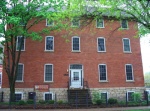Encyclopedia Dubuque
"Encyclopedia Dubuque is the online authority for all things Dubuque, written by the people who know the city best.”
Marshall Cohen—researcher and producer, CNN
Affiliated with the Local History Network of the State Historical Society of Iowa, and the Iowa Museum Association.
MARIA HOUSE: Difference between revisions
No edit summary |
No edit summary |
||
| Line 1: | Line 1: | ||
[[Image:maria.jpg|left|thumb|150px|]]MARIA HOUSE. Part of the [[OPENING DOORS]] program in Dubuque, Maria House was located in the 130-year old former sister's convent of [[ST. MARY'S CATHOLIC CHURCH]]. The idea of the site was suggested by Dubuque City Councilwoman [[MICHALSKI, Ann|Ann MICHALSKI]] in 1997. The core group were six Dubuque-area Catholic women religious congregations--[[SISTERS OF THE VISITATION OF THE IMMACULATE HEART OF MARY (SVM)]], [[SISTERS OF THE PRESENTATION OF THE BLESSED VIRGIN MARY (PVBM)]], Sinsinawa Dominicans, [[SISTERS OF CHARITY OF THE BLESSED VIRGIN MARY (BVM)]], Dubuque Franciscans, and the Detroit Sisters of Mercy]]. (1) | [[Image:maria.jpg|left|thumb|150px|]]MARIA HOUSE. Part of the [[OPENING DOORS]] program in Dubuque, Maria House was located in the 130-year old former sister's convent of [[ST. MARY'S CATHOLIC CHURCH]]. The idea of the site was suggested by Dubuque City Councilwoman [[MICHALSKI, Ann|Ann MICHALSKI]] in 1997. The core group were six Dubuque-area Catholic women religious congregations--[[SISTERS OF THE VISITATION OF THE IMMACULATE HEART OF MARY (SVM)]], [[SISTERS OF THE PRESENTATION OF THE BLESSED VIRGIN MARY(PVBM)]], Sinsinawa Dominicans, [[SISTERS OF CHARITY OF THE BLESSED VIRGIN MARY (BVM)]], Dubuque Franciscans, and the Detroit Sisters of Mercy]]. (1) | ||
Maria House offered transitional housing for women and children moving from homelessness to self-sufficiency and independent living. At its dedication, Curt Heidt, vice president of the Federal Loan Bank, said the project was one of the first faith-based housing developments to use the adaptive re-reuse of older structures, preservation of religious properties and addressing the needs of children now the fastest-growing population in public shelters. The facility opened on September 25, 2000. (2) | Maria House offered transitional housing for women and children moving from homelessness to self-sufficiency and independent living. At its dedication, Curt Heidt, vice president of the Federal Loan Bank, said the project was one of the first faith-based housing developments to use the adaptive re-reuse of older structures, preservation of religious properties and addressing the needs of children now the fastest-growing population in public shelters. The facility opened on September 25, 2000. (2) | ||
Revision as of 22:45, 20 September 2017
MARIA HOUSE. Part of the OPENING DOORS program in Dubuque, Maria House was located in the 130-year old former sister's convent of ST. MARY'S CATHOLIC CHURCH. The idea of the site was suggested by Dubuque City Councilwoman Ann MICHALSKI in 1997. The core group were six Dubuque-area Catholic women religious congregations--SISTERS OF THE VISITATION OF THE IMMACULATE HEART OF MARY (SVM), SISTERS OF THE PRESENTATION OF THE BLESSED VIRGIN MARY(PVBM), Sinsinawa Dominicans, SISTERS OF CHARITY OF THE BLESSED VIRGIN MARY (BVM), Dubuque Franciscans, and the Detroit Sisters of Mercy]]. (1)
Maria House offered transitional housing for women and children moving from homelessness to self-sufficiency and independent living. At its dedication, Curt Heidt, vice president of the Federal Loan Bank, said the project was one of the first faith-based housing developments to use the adaptive re-reuse of older structures, preservation of religious properties and addressing the needs of children now the fastest-growing population in public shelters. The facility opened on September 25, 2000. (2)
Maria house was able to accommodate twenty women and children for stays up to one year. The first floor offered a lounge with overstuffed chairs and a wide-screen television, a conference room and offices for the four permanent staff members. A large dining room, commercial kitchen, laundry room and small activity room were located in the basement. (3)
---
Source:
1. Nevans-Pederson, Mary. "Community Need Brings Convent Back to Life," Telegraph Herald, September 22, 2000, p. 3
2. Ibid.
3. Ibid.


